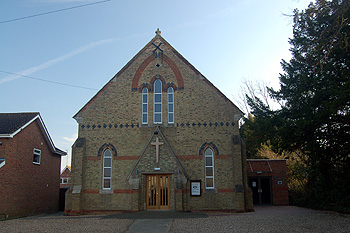
The Methodist chapel March 2012
A. A. Gilbert’s notes on Wootton [CRT130Wootton14] state: “The Wesleyans were apparently the first Free Church to attempt to hold properly organised meeting to worship as their conscience dictated and a license to worship in that manner was applied for in the name of Daniel Cooke to be held in his house in March 1806 the certificate was again applied in the name of Samuel Sheffield in April 1807 and again in 1810 from the house of John Vaux and additionally John Curtis, Thomas Warren, John Thomas and Daniel Cook”.
“In 1811 they purchased 3 cottages in Cause End Road and adapted it [sic] for church purposes in that year and opened it for worship in August of that year. The articles of agreement were signed by Ambrose Hurst, shopkeeper and John Curtis the younger, dealer in lace, both of Wootton and John Dowsett of Saint Cuthbert’s, Bedford, surgeon and apothecary. The cottages were later sold and converted to shop premises and is still in use for that purpose…”
The place of worship registered in 1811, when Wootton formed part of the Bedford and Ampthill Circuit, was, in fact, two cottages which stood on a piece of land 57 feet long by 24 feet wide in Cause End Road, adjacent to the Star Beerhouse. John Curtis the younger of Wootton, lace dealer and John Dowsitt of St.Cuthbert's, Bedford, surgeon and apothecary agreed to buy the site and buildings from Ambrose Hurst of Wootton, shopkeeper for £80 [STuncat403/1].
The following year Hurst duly conveyed the site and buildings to the Bedford Wesleyan Circuit trustees: John Curtis; Daniel Cook of Wootton, farmer; John Doswet; Richard Lovell of St.Peter's, Bedford, shoemaker; John Maynard of St.Peter's, Bedford, wheelwright; Isaac Wale of St.Paul's, Bedford, tailor; John Issett of St.Paul's, Bedford, butcher; William Cumberland of St.Mary's, Bedford, shoemaker and William Yates of Kempston, farmer [STuncat403/2].
New trustees were appointed in 1840 being: Thomas Poulton Clark of Ampthill, minister; Charles Armstrong of Wootton, farmer; James Isitt of Bedford, butcher; James Maynard of Bedford, wheelwright; Samuel Warren of Wootton, collar maker; James Hebbes of Wootton, brickmaker; Edward Estwick of Wootton, labourer [a William Estwick had lived in one of the two cottages in 1811]; James Summerfield of Wootton, labourer; William Furr of Wootton, labourer and Ebenezer Hebbes of Wootton, brickmaker [STuncat403/3-4].
On Sunday 30th March 1851 a census of all churches, chapels and preaching-houses of every denomination was undertaken in England and Wales. The local results were published by Bedfordshire Historical Records Society in 1975 as Volume 54, edited by D. W. Bushby. The return for the Wesleyan chapel, complied by Society Steward Charles Armstrong, noted that there were 90 free seats and 96 others. In the morning general congregation had been 46, with 100 Sunday scholars. In the afternoon it was 99 with 100 Sunday scholars and in the evening 140 with 40 Sunday scholars. Averages for the preceding months had been 84 and 96 in the afternoon and 145 and 35 in the evenings.
In 1862 the Bedford Circuit decided to purchase land on which to build a new chapel and schoolroom. In the end the Armstrong family donated both the site and £100 towards the building of the chapel, a further £100 coming from John Howard of Bedford.
The old chapel building was not sold for ten years after the new one was built - being conveyed to Charles Hebbes of Wootton, brickmaker for £40 on 25 April 1872 [STuncat403/5]. In 1875 Wootton was moved into the Bedford Saint Mary’s Circuit. In 1932 the Wesleyan Methodists came together with the Primitive Methodists and United Methodists to form the Methodist Church of Great Britain.
In 1942 it was transferred to the Bedford South Circuit. The chapel was extensively altered in 1964, additional amenities being provided. In 1971 the chapel was transferred to the Bedford South and Ampthill Circuit. Since 2010 Wootton has formed part of the North Bedfordshire Circuit.